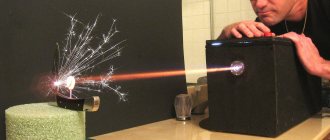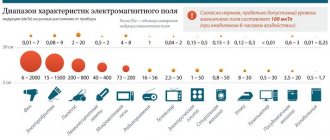The first microwave ovens were jokingly called bachelor's kitchen appliances. Perhaps the first generation of these devices justified this definition. But now microwaves have added so many different functions that their talents have become truly countless.
This device is controlled by a processor, which, based on the given parameters, can itself offer a recipe. And soon this wonderful culinary assistant will learn to perceive the voice commands of her mistress.
But, contemplating the leisurely rotation of defrosted products or the heating of ready-made dishes, you involuntarily ask yourself whether a microwave oven has an effect on the human body? This question is far from idle.
How harmful can microwave radiation be?
From a physics point of view, radiation from a microwave oven is not dangerous to humans, since it is not radioactive and its rays are not strong enough to penetrate the human body.
If you look at it from a nutritional point of view, the quality of foods heated in the microwave does not suffer either. Heating of food occurs due to the movement of water molecules inside the product, hitting each other, they transfer energy between themselves, due to which a large amount of heat is generated. In this case, nothing happens to the atoms of the food itself, and therefore the product cannot change. The same heating process occurs when cooking food on a regular stove, only on the stove heating occurs due to the thermal effect on the surface of the food, and microwave radiation heats the food inside too, since microwave rays can penetrate 2.5 centimeters deep.
In addition, the microwave oven is completely shielded and all radiation, being reflected, remains inside the device. When the door is open, radiation can get out, but all modern microwave ovens have a function that does not allow you to turn on the device with the door open, so there is no need to worry about this.
The physics of a microwave oven
Let's remember the basic concepts of a school physics course. The heating effect in a microwave is achieved due to the effect of microwave radiation on the products in the oven.
The source of these radiations is the magnetron. Microwave radiation frequency is 2450 GHz. The electrical component of this radiation has an orienting effect on the dipole molecules of the substance. A dipole is a molecule with charges of opposite signs at its different ends. The electric field manages to rotate the dipoles 180 degrees 5.9 billion times per second. This frantic speed leads to friction of molecules and heating of the substance consisting of them.
Microwave radiation penetrates no deeper than 3 cm, and further heating is carried out due to heat transfer from the outer layers to the inner ones. Pronounced dipoles are water molecules. Therefore, liquids and moisture-containing foods heat up faster. Vegetable oil molecules are not dipoles. Do not try to heat them in the microwave.
Microwave radiation used in a microwave oven has a wavelength of about 12 cm. Being on the frequency scale between radio and infrared waves, they have similar properties to them.
When radiation can be harmful
Indeed, according to scientific research, microwave radiation can change the molecules of the human brain for the worse, but don’t be scared! Any research is carried out with the full involvement of respondents, that is, they were exposed to long-term strong radiation. In ordinary human life, such an amount of radiation would not be accumulated in a lifetime.
Moreover, in order for such a strong effect to be exerted on the brain, you need to stick your head into a working microwave oven, which is a priori impossible due to the sophisticated design of the microwave oven.
A small impact on a person can occur if the screening in the furnace is broken, causing a leak, but these are extremely rare cases and, as already mentioned, the influence of the waves is so insignificant that it is simply impossible to notice any changes.
It is very rare that in the event of a leak, a person will be exposed to severe heat, which can lead to:
- burns on the skin;
- development of cataracts;
- temporary infertility (due to changes in the functions of the testes).
This happens extremely rarely, a one in a million case.
If we talk about food, then microwaves can spoil it if a person overdoes it with heating. You can spoil food in the same way on a regular stove.
What is it and how does it work?
The element generates high frequency radiation in the microwave. Food is heated by electromagnetic waves. The liquid molecules in the food begin to move, causing heating to occur. Therefore, food can warm up without external thermal influence. The temperature in the microwave does not exceed 100 degrees.
A magnetron works in the same way as a regular light bulb. High voltage is applied to the housing. It is the cathode. When the microwave is connected to the mains, electrons begin to rush to the anode.
The anode consists of a copper sleeve (cylinder with a lamp and tube). There are also vacuum sections inside and a tungsten filament that provides heat. There are magnets on the sides. From them, radiation moves along a spiral trajectory.
Electrons move through the resonator at high speed, which excites a high-frequency current. A stream of LED radiation appears. It is directed to the oven through the antenna.
The device of a magnetron in the microwave
Important! If the temperature inside the chamber exceeds the norm, burnout protection will work. This is provided by aluminum radiator fins.
How to check a microwave oven for leaks
For your own peace of mind, you can perform a simple microwave leak test. Most often, this problem affects devices that have experienced shocks or falls, as well as older models over 10 years old.
A professional test requires a special, expensive device, but at home you can use a regular smartphone.
Before checking you need:
- turn off the microwave oven from the network;
- put the smartphone inside;
- call the phone. If it is outside the access zone, then there is no leak, but if dialing is in progress, then there is a leak.
It is worth remembering that this method is not 100% accurate and you should not worry too much about the result. Microwaves operate at 2.4 MHz, and phones often use other frequencies, so this method doesn't always work. The shielding of a microwave oven is adapted to certain frequencies, but is capable of transmitting others.
How to check a microwave oven for radiation and leaks
On the vast expanses of the Internet you can find descriptions of several ways to test a microwave oven for radiation.
- Arm yourself with two mobile phones. Place one of them inside the microwave. Close the door. Call from the second mobile phone to the device “languishing in solitary confinement.” If it rings, then the microwave transmits radiation in and, accordingly, out.
- Place a glass of cold water in the microwave. Set the power to 800 W and time to 2 minutes. During this time, the water should boil. After finishing the experiment and turning off the device, carefully remove the glass of water. If the water boils under these conditions, everything is fine. If the water remains cold, it means that the radiation did not do its job and escaped.
- It is advisable to use the following method in the dark. Turn on the microwave for a while and bring a fluorescent lamp to it. If the light comes on, there is a leak.
- But this method is effective only in case of severe leakage. Turn off the lights and bring a bunch of keys to the door. The presence of even tiny sparks also indicates the transmission of microwave radiation.
- With the stove running, carefully run along the edge of the closed door. If it gets hot, there is a leak.
However, the effectiveness of all the proposed methods may be questionable. Testing using cellular devices is unreliable simply because the operating frequencies of mobile phones and microwaves are different.
microwave radiation detector
The most reliable method is to check using a special microwave radiation detector. Place a glass of cold water in the microwave oven, close the door and turn on the oven.
Bringing the detector close to its front wall, we trace it around the perimeter and diagonal of the door, fixing it at the corners. If there is no radiation, the indicator needle will not leave the green zone of the scale. If it is within the red zone, there is a leakage of microwave radiation. The method is effective and absolutely reliable.
What to do if a leak is detected
The first step is to inspect the microwave oven for damage, such as:
- cracks on the body and door;
- dents on the door;
- broken fasteners;
- chips on the door glass;
- violation of the integrity of the door screen;
- and the like.
If they are found, you need to contact a repair shop to fix the problem. Often, services have special devices for checking leaks; the technician will be able to accurately tell whether there are problems in this regard or not.
If a microwave leak was detected in a new device, then you need to contact the place of purchase; using the warranty card, the microwave will be sent for repair to a service center or exchanged for a new one.
Under no circumstances should you disassemble a microwave oven yourself without proper training and experience, as there is a risk of injury and even death.
Restoring the microwave oven in simple ways
A microwave oven (microwave oven) lasts quite a long time if you follow simple operating rules. When these simple rules are violated, then repairing a microwave oven, like any repair of electronic equipment, is quite expensive, and sometimes is not cost-effective compared to purchasing a new device.
The most common cause of malfunction in a microwave oven is a malfunction of the magnetron, which fails when overloaded. Magnetron overloads occur due to excess power dissipated on it. For example, installing a metal tin can or plate with a metal edging in the working chamber usually leads to just such a sad result. Also, you should not turn on an “empty” microwave oven. Sometimes, especially in the case of inexpensive models, this is also fraught with malfunction and subsequent repairs. In these cases, replacing the magnetron, and sometimes also the high-voltage diode, is required. Much less serious consequences are the failure of the plastic (or mica - there may be different options in different ovens) plug in the working chamber, which is a rectangular part, measuring 2.5 x 6 cm, separating the waveguide and magnetron antenna from the working chamber of the furnace, where food is placed to be heated. This plug prevents food particles from getting into the waveguide and the magnetron antenna.
Despite the apparent simplicity of diagnosing a malfunction and its subsequent elimination, experts do not recommend repairing a microwave oven yourself for two main reasons: firstly, you can get an electric shock (since there is a voltage of several kV in the electrical circuit of the magnetron), and secondly, you can be irradiated by a magnetron - an ultrahigh frequency generator. Both are dangerous to your health.
Therefore, I also recommend trusting the repair of microwave ovens to specially trained experienced craftsmen. And in this article we will analyze simple cases when you can save on repairs, because simple faults are diagnosed unambiguously, which allows, subject to increased safety measures, to replace the main elements of the microwave oven - the magnetron and the high-voltage diode, thereby quickly and at minimal cost restoring performance of this popular household device.
Let's look at two common faults and methods for localizing them. The first is a malfunction of the microwave oven, which is expressed in the absence of heating of the working chamber, and the second is a drop in power.
In the first case, it is necessary to replace the magnetron and check the serviceability of the high-voltage diode. Because in practice, the diode often fails when the magnetron malfunctions. A faulty magnetron will look absolutely “like new”, thus, there will be no external signs of its malfunction. It is possible to check its filament, but that’s not all. One simple way is to check the operation of the microwave oven “by ear”. Turn on the oven with a food product pre-installed inside the working chamber (for example, put a pie or a cut glass glass of water filled to 2/3 of its volume). A working furnace will make a steady noise. Crackling, loud sound of “strained operation of the transformer” (the winding of which is also loaded with the magnetron filament power circuit) indicates a malfunction. Immediately turn off the oven and prepare a replacement magnetron.
To establish the high-quality operation of a household microwave oven, use the following, quite common, test. Take 1 liter of water poured into a glass jar, place it in the working chamber, measure the temperature with a high-quality (reliable, proven) digital thermometer (for quick measurements), then turn on the oven for 62 seconds. After heating by microwave waves is completed, stir the water in the jar and measure the temperature again. Based on the temperature difference, determine the power based on the following correspondence: the difference in the TC corresponds to the power of the “defrost mode” of 490 W. By analogy, the difference is 8°C - 560 W, 9°C - 630 W, 10°C - 700 W, 11°C - 770 W, 12°C - 840 W, 13°C - 910 W, 14°C - 980 W, 15°C - 1050 W, 16°C - 1120 W, 17°C - 1200 W.
How to check the magnetron?
The lack of available simple methods for reliably checking the serviceability of magnetrons in microwave ovens creates certain problems during repairs. The method proposed below, although it requires the use of an oscilloscope in high voltage measurement mode. however, I will present it here because it allows you to quickly check the performance of the magnetron and the components of the high-voltage multiplier, in which the main element is a high-voltage diode. The photo at the beginning of the article shows a view of the open housing of a household microwave oven, a view of the magnetron and the magnetron power supply.
The magnetron in the circuit of a household microwave oven is used as one of the voltage doubler diodes. This property allows you to check it as a diode if you have a working standard diode. Alternatively, viewing the voltage waveform at the magnetron cathode with an oscilloscope allows you to obtain information about its performance, problems and power conditions. To do this, use a standard 30 kV high-voltage divider (you can use a homemade high-voltage divider consisting of 3 high-voltage resistors with a resistance of 33 MOhm each and one 30 kOhm, to which the oscilloscope input is connected). The grounding terminal is securely connected to the microwave oven body.
When the microwave oven is turned on, negative half-cycles (50 Hz pulses) with an amplitude of up to 4 kV are observed on the oscilloscope screen. It is appropriate to note that the shape and amplitude of the pulses are influenced by the elements of the high-voltage power source. By changing the shape of the leading edge, one can observe the magnetron entering the operating mode as the filament warms up and the stability of its operation in the active mode. Using an oscilloscope, defective capacitors and high-voltage diodes are identified. When the magnetron is inoperative, a sinusoid with an amplitude of about 2 kV is observed on the screen. By carrying out the described experiment in the form of several control measurements on a known-good microwave, you can obtain the necessary skills for repairing faulty microwave installations. So, to determine the quality of the magnetron, it is enough to turn on the microwave oven through a powerful LATR, reducing its supply voltage by 25...30%. The appearance of a magnetron removed from a faulty household microwave installation is shown in Fig. 1.
Rice. 1
Attention, important!
Of course, when measuring, it is necessary to take into account the presence of high voltage and comply with existing safety standards.
How to diagnose a faulty high voltage diode
A high-voltage diode in a microwave oven can be used in different types; its purpose and operating principle are the same. The diode is usually designated on the board as DB1, and the type itself may have different designations, for example, 10С1В 3000 K S13, Shine 50 Hz 1368, etc. You can replace a high-voltage diode in different microwave ovens with another similar one without any damage to the device. In my practice, I have tested replacing the high-voltage diode with CL01-12, 060TM, HVR-1X, 2X062H, L5KVF. Different manufacturers label such a diode in their own way.
Figure 2 shows a type of high-voltage diode used in modern household microwave ovens.
Rice. 2
According to the electrical characteristics, the high-voltage diode is designed for a current of up to 700 mA at a maximum voltage of up to 5 kV. These parameters also explain the impossibility of its practical testing (“diagnosis”) using conventional multimeters with a maximum resistance measurement limit of 2 MOhm. In this case, the tester shows a “break”. The voltage that unlocks the diode charges the high-voltage capacitor of the microwave oven to the amplitude value. In this case, the voltage on the magnetron is very low compared to the working one. When the voltage polarity changes, the diode is turned off and the total voltage on the winding and capacitor is applied to the magnetron.
To check this high-voltage diode and make sure it is working, you can go in two ways. The first is to check in resistance measurement mode with an ohmmeter with a resistance measurement limit of up to 200 MOhm (it is designed to measure the insulation resistance of wires), the second is to check practically by connecting 100-230 V alternating voltage to the circuit. In domestic conditions, this method is most often used: in compliance with safety rules, one contact of the diode is connected in series to a 230 V electrical circuit (to one of its conductors) and in the mode of measuring direct voltage in the 250 V sub-range (and above), a multimeter measures the voltage between the other conductor (230 V / 50 Hz network ) and another contact of the high-voltage diode. Provided that there is voltage in this case, and the diode was not determined to be short-circuited by a preliminary check with an ohmmeter, its serviceability is recognized.
If the heating power of the microwave oven has dropped, this is noticeable by the weak heating of the food and/or the need to spend noticeably more time on heating, despite the fact that until recently “the oven was heating well.” Of course, this case is not difficult in terms of financial and time costs, and replacement of the magnetron is not necessary. To troubleshoot, consider two ways.
First. We visually check the mica (or plastic) gasket in the working chamber opposite the magnetron waveguide. The gasket (otherwise called a plug) is necessary to protect the magnetron antenna (waveguide) from particles of the heated products themselves getting on them. In principle, burnout of a mica or plastic gasket is a common malfunction of modern microwave ovens. To avoid this problem, the gasket can be additionally painted with special food enamel (from the side of the working chamber of the microwave oven).
Second. We check the supply voltage in the outlet directly at the microwave oven plug. It has been established that even a slight drop in the supply voltage has a very significant effect on the heating power of products in the working chamber. Moreover, all other “attributes” of the microwave oven operation remain unchanged, and the device operates as if normally. So, when the supply voltage decreases to 200 V, the microwave oven loses approximately 50% of its power. This must be taken into account.
When replacing feed-through capacitors from the magnetron fixed in the stove, remove the filter cover. Using a screwdriver, we separate the “common wire” of the capacitors from the filter housing. Using an ohmmeter, we determine whether the capacitors are broken. In practice, repair of feed-through capacitors of the magnetron filament leads can be carried out by destroying the capacitor housing with pliers or wire cutters, and soldering new, known-good capacitors of any type with a capacity of 200 pF and higher at the appropriate operating voltage, then filling the free space with epoxy glue or compound to insulate the capacitor leads.
But this path does not seem to be of very high quality; rather, it is convenient where there is no other way to do it. In a working laboratory, it is quite possible to find a more productive solution. For example, replace old feed-through capacitors with new ones that are known to be good, removed, for example, from a working microwave oven. And thus carry out the check, reducing the likelihood of a malfunction in part of the feed-through capacitors in the magnetron filament circuit.
A typical electrical circuit of a household microwave oven with a digital indicator is shown in Fig. 3.
Rice. 3
In each of the cases considered, carrying out repair work makes sense, since it saves both time and money on repairs.
Author: Andrey Kashkarov, St. Petersburg Source: Elektrik 6/2016
Some common myths about microwaves
There are many popular myths about microwave ovens, but these are the most popular among them.
Myth #1. Microwave oven kills food
In fact, all food is “dead”; only bacteria remain alive in it for a long time, which subsequently causes its spoilage.
For example, fruit molecules “die” immediately after they are picked.
Myth #2. Microwaves may cause cancer
Radiation from a microwave oven is not capable of causing changes in the human body; this requires long-term sustainable exposure, which does not occur in everyday life.
Calling over a Wi-Fi network
An experiment with a phone call over a Wi-Fi network will be more objective. To do this, you can use applications such as Viber, What`s up or Skype.
Wi-Fi works through radio waves, the length of which is as close as possible to the length of microwave microwaves. Ovens for domestic use occupy the frequency of 2450 MHz, Wi-Fi is mainly 2400 MHz, while mobile communications occur in the range of 900-2100 MHz.
If you can’t reach the subscriber via the Internet, then the stove operates at “5+”. But keep in mind that in an apartment where a 5 GHz router is installed, this experiment is pointless.
Pros and cons of the negative impact of microwaves on food
There are whole discussions about the dangers of microwave ovens. On the one hand, it proves why a microwave oven is dangerous for humans. On the other hand, the harm of a microwave oven within the framework of proper operation is refuted.
There are suggestions that the ultrahigh frequencies at which a microwave oven operates affect the molecules of products, deforming and destroying them. In this case, compounds appear that do not exist in nature. In addition, there is a lot of debate between nutritionists and physicists regarding the ionization of water molecules that heated food contains. Ionization is the gain or loss of one electron by an atom. In this case, we can talk about a change in the structure of water.
They tried to prove the danger of this process by experimenting with plants. Two identical plants were taken. One of them was watered with water, which was boiled in the traditional way. The second is water boiled in the microwave. The last plant died after nine days. Then the opinion arose that water in a microwave oven becomes dead and has a detrimental effect on living organisms, including humans.
In contrast, physicists prove that waves of the same length that are used in a microwave oven cannot ionize products. They do not affect the structure of the water, but simply heat it. Moreover, due to the high heating rate, food loses a minimum of nutrients.
The opinion of adherents of microwave ovens is countered by various studies that prove that foods heated in this device lose in nutritional quality.
For example, Japanese researcher Watanabe claims that milk heated for six minutes becomes less healthy. Australian scientists prove that when heated in the microwave, protein coagulates faster.
It is also prohibited to heat blood for transfusion in a microwave, because it can kill the patient. In 1991, there was a case where blood heated in this way led to death.
Symptoms of the harmful effects of microwaves on the body
The slightest leak can lead to the accumulation of dangerous effects on human health. Sooner or later this can lead to the following symptoms:
- sleep disturbance,
- irritability,
- depression,
- problems in cognitive function,
- dizziness,
- headache,
- sweating,
- nausea,
- loss of appetite,
- thirst,
- blurred vision
- enlarged lymph nodes,
- frequent urination,
- weak immunity,
- signs of heart failure.
The dangerous effect on children is that they begin to act up and become nervous.
These signs should make you wonder whether there are any problems with the seal of your kitchen assistant.
To avoid danger
If you have a microwave oven in your home, you need to follow certain rules when operating the device. It is very important to keep it clean and remove carbon deposits on time.
It is recommended not to place the microwave near a gas stove or table where the family gathers. When the stove is on, do not stand nearby.
Do not place metal utensils in the microwave oven. This is strictly prohibited, as metal or metallized paint will damage the magnetron and the protective casing.
Completion
A microwave oven can cause great harm to human health if the rules for its use are neglected. To prevent radiation symptoms from appearing in you or your loved ones, check the microwave for leaks. Do not use a device that transmits radiation.
As for the debate among scientists regarding the dangers of eating food cooked in a microwave oven, they most likely will not end soon. Therefore, the decision whether to use a microwave or not will have to be made independently. Approach your decision armed with knowledge!
- Author: Elena
Rate this article:
- 5
- 4
- 3
- 2
- 1
(0 votes, average: 0 out of 5)
Share with your friends!










